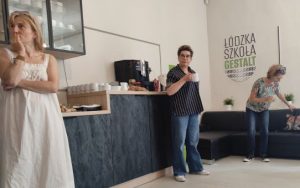Program and class topics – Year 1.
- Interpersonal training with elements of integration
- History and roots of Gestalt, code of ethics
- Diagnosis – a comparative approach and psychopathology
- Self theory
- The cycle of experience
- Mechanisms for entering contact/style of contact
- The therapeutic process and the structure of the therapy session
- Experimentation in individual psychotherapy
- Resistance work according to Enright
- Supervision and credit for therapeutic practice
Program Year 1
Starting with Year 1 of the psychotherapy school, each trainer leading the workshop begins the class by presenting a demonstration therapy session, which is then discussed taking into account:
– putting into practice the bit of Gestalt theory that the class is about (e.g., presenting an experiment, working with a chair, working with a dream, etc.).
– Conceptualizing the problem in terms of:
- theory of self
- distinguish the stages of the cycle of experience
Each workshop consists of a group process section (2 hours at the beginning of the meeting and 1 hour at the end) and an educational section.
1. interpersonal training with elements of integration
Interpersonal training introduces the School Stage. This is the first meeting with the group of people with whom you will be learning to be a Gestalt therapist for the next three years. The goal of the class is for people in the group to get to know each other, to experience themselves in interactions, to go through the phases of the group process in order to be in contact with others in all possible shades of relationships.
2. sexuality – own work
In psychotherapy, the perception of the topic of sexuality has a wide range. It is worth taking into account that the sphere of sexuality is influenced by the cultural, social, religious context, gender and sexual identity, and the values by which the person receiving therapy functions. At the same time, in the relational experience of co-creating the therapeutic field, what the therapist brings is an important part. One’s own patterns, experiences, contact with one’s own sexual aspects, contribute to the development of the therapeutic process or its inhibition.
Our ability to provide therapeutic assistance in the area of sexuality depends on our ability to look critically at our own sexuality, in terms of the presence of stereotypes, prejudices, violence. Separate what is “mine” from the introjects and beliefs adopted in the process of upbringing and socialization.
The classes provide an opportunity to update knowledge of sexuality, both one’s own and those receiving therapy. Addressing this topic is also important because of the dynamic changes that are taking place in the area of knowledge about human sexuality. It is important to “keep up ” with the rapidly changing needs of patients, resulting from the increasing awareness of people coming forward for therapy and the increasing consent and willingness to express gender identity, psychosexual identity and sexual behavior.
During the class:
- you will look at your own sexuality, your beliefs, prejudices, and what is alive in it
- you will gain more freedom to talk and navigate the area of sexuality
- you will learn how to experience your own aspects of sexuality while being in the role of therapist(s)
- you will learn what to do with sensory experiences, how to use them to serve the therapeutic process
- You will become sensitive to the concept of the norm in the broader customer field
- you will look at the client’s sexual difficulties from a Gestalt relational perspective
Literature:
- Francesetti, G., Gecele, M., Roubal, (2018). Gestalt psychotherapy in clinical practice: from psychopathology to aesthetics of contact. Harmonia Universalis.
- Resnick, S. (2004). Somatic-experiential sex therapy: A body-centered Gestalt approach to sexual concerns. Gestalt Review, 8(1), 40-64.
- Spagnuolo Lobb, M. (2009). Is Oedipus still necessary in the therapeutic room? Sexuality and love as emerging at the contact-boundary in a situational field. Gestalt Review, 13(1), 47-61.
- Kincel, A. (2020). Exploring Masculinity, Sexuality, and Culture in Gestalt Therapy: An Autoethnography.
- M. E. Metz, B. W. McCarthy. (2007). The ”Good-Enough Sex” model for couple sexual satisfaction. Sexual and Relationship Therapy Vol 22, No. 3.
- Maria Beisert. (2006). Sexuality in the life cycle. PWN.
- ed. B. Grabski, M. Mijas, M. Dora and G. Iniewicz. (2020). Dysfunction and gender incompatibility.
- ed. G. Iniewicz, M. Mijas, and B. Grabski, (2012). An introduction to LGB psychology.
- ed. Silva Neves, Dominic Davies, (2023). Erotically Queer: A Pink Therapy Guide for Practitioners.
- ed. Silva Neves, Dominic Davies, (2023). Relationally Queer: A Pink Therapy Guide for Practitioners.
- ed. Ayhan Alman, John Gillespie, Vikram Kolmannskog, (2023). Queering Gestalt Therapy, An Anthology on Gender, Sex & Relationship Diversity in Psychotherapy
- ed. Marta Dębowska, Piotr Galecki, Agata Szulc, (2019). Sex and mental health.
- Philippson Peter, Working with sexuality in Gestalt psychotherapy (video)
- Mariano Pizzimenti, webinar “Sexual diversity according to Gestalt therapy” (video)
3 Diagnosis – a comparative approach and psychopathology
The workshop will discuss different views of the diagnosis process: differential and phenomenological. The DSM and ICD disorder classification systems will be discussed. Participants will learn experientially the essence of phenomenological diagnosis, based on the study of the contact between therapist and client “here and now.” The Gestalt approach (Roubal, Francesetti, Gacele) will be discussed, distinguishing between external diagnosis, i.e. mapping the problem area (which allows the therapist to determine the meaning of the problem, set realistic goals and choose working tools) and internal (aesthetic) diagnosis, in which the therapist is guided by an intuitive sense of the quality and beauty of the relationship happening here and now. The workshop will also discuss such issues as:
– typologies of character structures (Lowen and Reich)
– character types (Cassius)
– character structures (Keleman)
– causes of mental disorders
– The issue of health and disease and the norm in psychopathology.
Literature:
- Francesetti, G., Gecele, M., Roubal, J., & Mizerska, R. (Eds.). (2018). Gestalt psychotherapy in clinical practice: from psychopathology to aesthetics of contact. Harmonia Universalis.
- Rosenhan, D. L., & Seligman, M. E. P. (1994). Psychopathology, Warsaw: Wyd. Polish Psychological Association
- ICD -10
- DSM-IV
4 Self Theory
The workshop is designed to provide an introduction to the theory of the self and to show its practical implications in working with clients. Self is understood as a process of becoming in the experience of boundary contact with the environment. It is not any fixed structure or property, but a state “happening” in constant motion. The purpose of self is to contact. The workshop involves tasting and experiencing the self and its manifestations such as the id function, ego function and personality function.
Participants will focus on recognizing sensations, feelings, “subcutaneous” arousal (Salonia), and emotions emerging from the body (id function) to reach the intentionality that leads to a “yes” (whether what emerges from the background is to be assimilated) or “no” (whether what emerges from the background is to be rejected) decision (ego function). Participants will also explore the function of personality, that is, who we become as a result of accepting or rejecting an impression. During the course of the class there will be an opportunity to observe both the “working” self in one’s own experience and the “working” self of the client in boundary contact with the therapist with special attention to how different types of problems manifest themselves in the various functions of the personality. Participants will learn to take the right direction in therapeutic work and apply appropriate interventions.
Literature:
- Ginger, S., Drabik, W., & Zaleska-Stolzman, M. (2004). Gestalt-the art of contact. Publisher. Jacek Santorski & Company.
- Francesetti, G., Gecele, M., Roubal, J., & Mizerska, R. (Eds.). (2018). Gestalt psychotherapy in clinical practice: from psychopathology to aesthetics of contact. Harmonia Universalis.
5. the cycle of experience
Once again, Participants will look at the cycle of experience. This time we will work on Josef Zinker’s model and James Kepner’s model mainly in terms of how the cycle manifests itself in therapeutic work with the client and what are the therapist’s tasks in connection with each phase of the self-regulation cycle.
The cycle of experience is one of the basic Gestalt concepts. Every session and every therapeutic process is based on the cycle.
During the class, participants will experience and try to name such elements of the self-regulation cycle as:
- impression,
- awareness,
- mobilization,
- action,
- contact (meeting a need),
- assimilation,
- withdrawal.
The above elements make up the schema of any human contact with the environment (with oneself, or with another person), they tell the story of how a person (customer) comes into contact to satisfy his need. It could be the establishment of relationships in close relationships, the way one organizes one’s work (e.g., leading to professional burnout), it could be the topic of accepting some part of oneself, etc. The workshop this time is not so much to familiarize the participants with the concept of the cycle itself, but aims to train them in the skills of conceptualizing therapeutic work with the client.
Literature:
- Joseph Zinker “The creative process in Gestalt psychotherapy”, Jacek Santorski &Co Warsaw 1991
- James Kepner “The body in Gestalt psychotherapy”, Empty Cloud Publishing Warsaw 1991
- Ch. Sills, S. Fish, P. Lapworth “Gestalt psychological help,” Institute of Health Psychology 1999
- “The contact sequence: an absurdly brief description of a typical model”, Dan Bloom [w:]
<http://bibliotekagestalt.pl/2021/01/15/bloom-dan-sekwencja-kontaktowania-absurdalnie-krotki-opis-typowego-modelu-tekst/>
6. mechanisms for entering contact/style of contact
Participants come into contact for the second time with the issue of contact styles or otherwise avoidance mechanisms. Mechanisms are the kind of defenses that humans put up to guard values that are important to them, and they do so unconsciously, of course. Mechanisms are, in other words, interruptions in contact that reveal themselves at different points in the cycle of experience. The class will discuss such styles/mechanisms as:
- introjection (unconscious acceptance/recognition of a belief),
- retroflection (stopping ekpression),
- projection (attributing one’s own concerns, judgments to the environment),
- prophylaxis (acting for the environment to give to contact what we ourselves would like to receive),
- confluence (fusion, fusion with another person, with the situation),
- deflection (distraction on side threads, so as to avoid meeting each other),
- egotism (excessive preoccupation with one’s own thoughts, feelings, influence on others).
This time, participants, in addition to being reminded of what contact breaks are, will learn to identify them in the therapeutic process with the client and apply appropriate interventions to each of them.
Literature:
- “The Theory and Practice of Gestalt Therapy” Jerzy Mellibruda
- Gestalt journal – “Mechanisms of contact avoidance” Jacek Pierzchała
- “Gestalt the art of contact” by Serge Ginger
- “Gestalt Therapy” by S. Perls Frederick
- “Gestalt Therapy, (100 Key Points),” by Dave Mann, 2010.
7. the therapeutic process and the structure of the therapy session
Gestalt therapy is a processual phenomenon. It happens in time, it has a beginning, a proper part and an end. Processuality emerges from what is created in the encounter between therapist and client at the boundary of contact. Individual figures emerge from the background, the experience happens in a cycle. The classes are geared towards experiencing the phenomenon of the Gestalt process, with its phases distinguished by Victor Chu:
- Preliminary phase. Entering into a contract
- Phase I. Awareness. Awareness
- Phase II Accountability, integration and decision-making
- Phase III. Experimentation (activities)
- Phase IV. Consolidation.
The processual nature of the therapy session itself is also a matter of course. Participants will learn about the different stages of the session:
– emergence of need
– intensity and experience of need
– emergence of resistance, intensification of contradictory tendencies
– Identification of the topic containing the need and the resistance caused by it
– emergence and intensification of the impasse
– breakthrough experience
– insight
– Assimilation of new experience.
Participants will learn how to recognize the different moments of the therapeutic process and the process happening in a single session. They will learn what to pay attention to at each stage, how to accompany the client so that the process can proceed freely. Specific interventions that are appropriate at each stage will also be discussed.
Literature:
- Chu, V. (1994). Gestalt Psychotherapy. Canon.
- Jakubowska U. (1994). A humanistic-existential approach, [w:] Grzesiuk L. (ed.) Psychotherapy. Schools, phenomena, techniques and specific problems, Warsaw: Wydawnictwo Naukowe PWN.
- Melibruda J. (1980). Theory and Practice of Gestalt Therapy, [w:] Wardaszko- Łyskowska H. (ed) Group Therapy in Psychiatry, Warsaw: PZWL.
- Feltham i., Horton C. (2013). Psychotherapy and counseling, Gdansk: GWP.
- Ginger S., Ginger A. (2010). A psychotherapist’s practical guide. Zakrzewo: Replica.
8. experimentation in individual psychotherapy
Experimentation in individual therapy is inviting the client to experience some part of himself in a new way, in a safe environment, in trust with the therapist. The experiment happens in the therapeutic process, at the right time for the client. A Gestalt experiment is never pre-planned, and the therapist cannot expect its outcome. It is a creative activity, a proposal resulting from the vividness of the contact between the therapist and the client, resulting from the emerging figure, from the needs of the client, reinforced by the trust and experience of the therapist.
An experiment in Gestalt is always an invitation to act in the “here and now” (Zinker 1991), not a cognitive activity or inner experience. It assumes movement and action, so as a result of the experiment, the customer can experience a corrective experience. Maybe do something in a new way. Zinker believes that an experiment is the conversion of thinking or experiencing something into doing it.
During the class, participants will practice experimentation in individual therapy sessions, and will learn about the goals, rationale and types of Gestalt experiments.
Literature:
- Zinker, J. (1991). The creative process in Gestalt therapy. Warsaw: Wydawnictwo Jacek Santorski & Co.
- Chu, V. (1994). Gestalt Psychotherapy. Canon.
- Ginger S. (2004), The art of contact, Jacek Santorski &CO Publishing Agency, Warsaw, Poland
- Kepner J. (1991), The body in the process of Gestalt psychotherapy, Empty Cloud Publishing House, Warsaw, Poland
9. resistance work according to Enright
Gestalt therapy places the phenomenon of resistance as a central and creative element in identity and personality development (Bandin). Resistance is treated as a creative adaptation that enabled the client to survive or adapt to habitual patterns of family reactions in the past. Resistance always happens at the boundary of contact, so we are dealing with resistance from the client, the therapist and resistance arising in the relationship between them.
In the course of therapy, the Gestalt therapist helps bring the client’s fossilized resistances to the forefront so that he or she can experience them as an actual activity that is still being done (in movement, with muscle involvement, in the present). The actual experience happening in the “here and now” allows the client to access and make modifications in the resistant, habitual way of reacting. Resistance in Gestalt is not an enemy to be defeated but a figure to be worked with, confronting the client as much as possible at a given stage of the therapeutic process. Participants will train in working with clients according to J. Enright’s procedure containing 5 elements:
Stage 1 – recognition of willingness to participate in therapy
Stage 2 – identifying what is the essence of the customer’s problem
Stage 3 – determining whether the goal is achievable
Stage 4 – accepting the person of the therapist
Stage 5 – study of competing motives.
Literature:
- Enright J. (1984). Therapy and counseling without resistance, [in]: ed. Santorski
- New strategies and techniques for psychological assistance, Warsaw: PTHP.
- Bandin C. V. Toward an understanding of resistance in Gestalt therapy in: http://bibliotekagestalt.pl/dokumenty/W_strone_rozumienia_oporu.pdf
- Kottler J. A. (2007). Resistance in psychotherapy. How to work with difficult customers. Gdansk
10. supervision and credit for therapeutic practice
The class will consist of a credit for therapeutic practice in front of a supervisor. Each Participant will have a contracting session with the Client.




